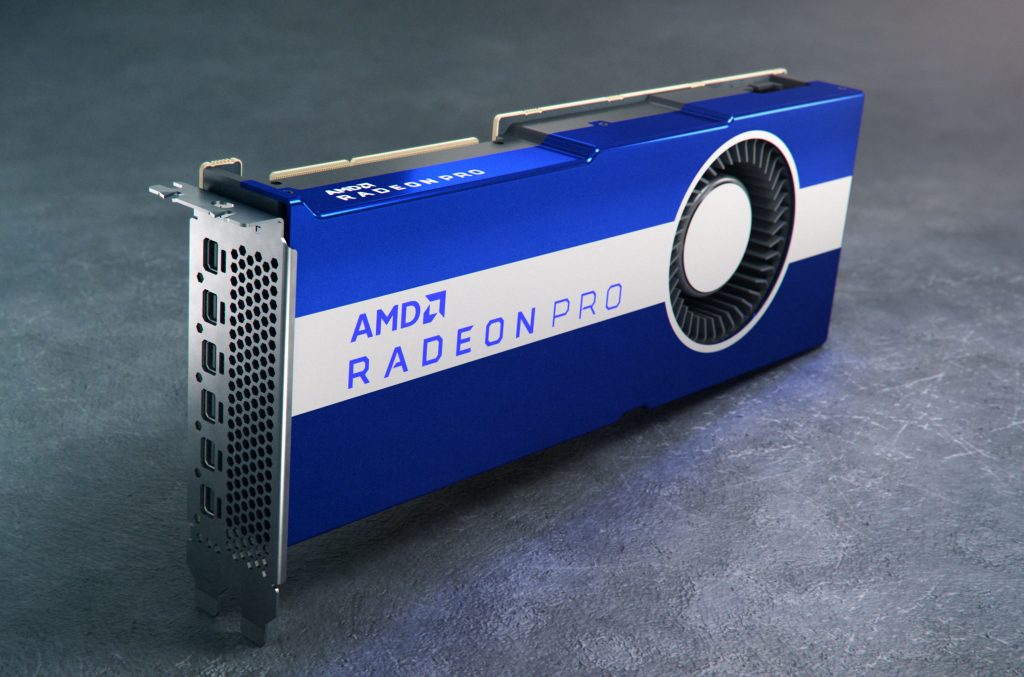AMD is targeting users of engineering simulation software with its new $1,899 AMD Radeon Pro VII GPU, announced today.
The important features of this new 250W, dual slot workstation GPU are up to 6.5 TFLOPs of double precision performance, 16GB HBM2 memory, support for PCIe 4.0 and the ability to combine two Radeon Pro VII GPUs and double the memory to better handle larger datasets.
Most simulation solvers rely on double precision calculations for accuracy but in recent years it’s only specialist GPUs like the Nvidia Quadro GV100 (32GB) and Quadro GP100 (16GB) that have been able to handle double precision efficiently.
Other AMD Radeon Pro GPUs and Nvidia Quadro RTX GPUs will support double precision but, relatively speaking, the performance is poor. More often than not, however, it is those cards you’ll see being used, says AMD. This comes down to price and with the Radeon Pro VII AMD is promising much more for your money.
For the cost of a single Nvidia Quadro GV100 ($8,999) the company claims you can get two Radeon Pro VII GPUs and still have up to $5,000 to spend on other parts of your workstation, such as high-performance storage.
Combining two Radeon Pro VII GPUs in a single workstation not only doubles performance to 13.1 TFLOPs but creates an accessible memory pool of 32GB, which can help improve performance with large datasets. This is made possible by Infinity Fabric Link, a high-bandwidth, low-latency direct connection that allows memory sharing between two AMD Radeon Pro VII GPUs. It delivers speeds of up to 168 GB/s, peer-to-peer between GPUs.
The big challenge for AMD is software compatibility. While the Radeon Pro VII will work with BETA CAE ANSA, Altair EDEM, Altair Hyperworks, Dassault Systemes Abaqus/Standard, Hexagon MSC Apex and others, there is still a lot of simulation software that only runs on Nvidia CUDA, which is not directly compatible with AMD hardware.
AMD does have a software tool called HIP that can translate CUDA code so it can run on the Radeon Pro VII and other OpenCL hardware, but AMD will need to get the ISVs on board for support.
AMD confirmed that is talking to a range of partners to ‘ensure that software that can’t currently run on AMD GPUs will be able to in the future’.
It is also working closely with developers to deliver applications that will have support for Infinity Fabric and, hence, be able to utilise 32GB in a dual GPU workstation.
AMD highlighted the OpenCL-based Altair EDEM as a key application, claiming the Radeon Pro VII delivers up to 5.6x more performance per dollar than the Nvidia Quadro GV100. The specialist simulation tool is used to optimise how heavy machinery handles bulk materials.
The Radeon Pro VII is not just for simulation. AMD also highlights the benefits for broadcast and media professionals for the creation of high-res media and digital signage.
In the engineering space, this would extend to design viz, wireless VR and large-scale visualisation on powerwalls with up to 6x synchronised displays.
AMD also introduced a beta SDK of AMD ProRender 2.0, its next generation physically-based rendering engine, highlighting support for Infinity Fabric so users can work with larger scenes.
While ProRender is predominantly a GPU renderer, the software is now able to better harness the power of AMD’s Threadripper CPUs as well.
AMD shared some benchmark figures: the Radeon Pro VII completed a test scene in 2,180ms while the 64-core AMD Ryzen Threadripper 3990X did it in 2,606ms. When used together, however, this brought the time down to 1,163ms.
AMD has also extended the reach of its rendering software, introducing a new Radeon ProRender plug-in for Unreal Engine, which includes support for Unreal materials.
Finally, the Radeon Pro VII will also support AMD Remote Workstation technology which is particularly relevant during COVID-19 lockdowns as it allows users to access their workstation from anywhere, on any client.






